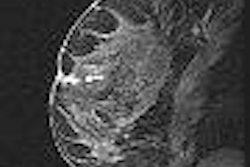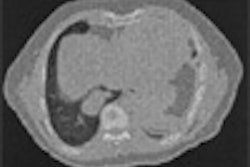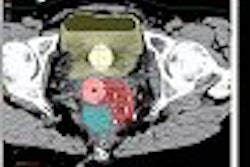CHICAGO - As CT scanners continue to nab ever-smaller lung nodules, the impetus has grown to do something about them, especially the diminutive nodules that look suspicious for lung cancer on the CT data.
In the RSNA's interventional lung session on Wednesday, Dr. Demetris Patsios from the University Health Network and Mount Sinai Hospital in Toronto, Canada, presented a study on the efficacy of MDCT-guided fine-needle aspiration biopsy (FNAB) of subcentimeter nodules, concluding that FNAB is a useful tool, if less accurate than FNAB of larger lesions.
"Percutaneous fine-needle aspiration biopsy is an accepted clinical tool for the evaluation of suspicious nodules," Patsios said. "In our institution, it is considered for any nodules bigger than 5 mm in diameter…. In our institution, we are participating in a lung cancer screening study, and screening-detected lung nodules are frequently less than 1 cm."
The relative contraindications for the procedure are chronic obstructive pulmonary diseases, hypertension, arteriovenous malformations … and previous pneumonectomy, he said. The most common complication at the authors' institution is pneumothorax, which is documented in the literature at rates ranging from 19% to 60%.
Most cases of pneumothorax occur within the first hour following the procedure, and the majority of patients remain stable and do not require further intervention, although chest tubes are inserted in 2% to 14% of patients, Patsios said. The risk of pneumothorax depends on both technical and patient factors, including the size and location of the lesions, and the caliber of the needle used for FNAB.
In the retrospective study, 32 biopsies were performed on previously undiagnosed pulmonary nodules smaller than 1 cm (5-8 mm: n = 7, 9-10 mm: n= 24, one unsuccessful) in the maximum long-axis diameter -- representing approximately 1% of all FNABs performed during the study period.
The standard technique included local anesthesia, sedation in some cases, single pleural puncture, and a coaxial technique with a 19-gauge Bard Truguide coaxial needle (C.R. Bard, Murray Hills, NJ) and 22-gauge Greene biopsy needle (Cook, Bloomington, IN).
The procedure was successful in all patients. Single-slice CT and chest radiography was used to follow up all patients immediately after the procedure and for several hours afterward. These imaging exams recorded complications that included one small hemothorax and 13 pneumothoraces, one of which required chest-tube intubation.
On average four fine-needle aspirates were taken per nodule. The average distance from the costal pleura was 34 mm (range 0-72 mm) and the pleura was crossed once in 26 of 31 FNAB procedures.
"Nineteen of 31 fine-needle aspirates (61%) were diagnostic, and (14 of 19) were due to primary or secondary malignancy," Patsios said. "Seven of 31 had no definite diagnosis following the procedure, and did not have any evidence of primary or secondary neoplasia at follow-up, which varied between one and two years." In five of 31, the samples were insufficient for diagnosis or negative.
Thus, the sensitivity for malignancy was 74% and the overall success in terms of the outcomes was 84%, Patsios said. The principal limitations were multiple operators with varying experience, a small cohort, and the retrospective nature of the study.
"CT-guided percutaneous fine-needle aspiration is a useful tool in the diagnosis and management of small pulmonary nodules," he said. "The sensitivity is lower than that of larger sampled pulmonary lesions … and there is a higher complication rate (42%) compared to lesions which are bigger than 1 cm."
By Eric Barnes
AuntMinnie.com staff writer
December 1, 2005
Related Reading
EUS-FNA, mediastinoscopy combo boosts preoperative lung cancer staging, August 23, 2005
Percutaneous lung biopsies safe, effective in children, September 22, 2004
CT-guided lung biopsy cuts time, expense, and risk in kids, June 4, 2003
Fine-needle aspiration helpful in pancreatic cancer diagnosis, January 29, 2003
Fine-needle aspiration biopsy highly accurate with adequate training, September 5, 2001
Copyright © 2005 AuntMinnie.com



















